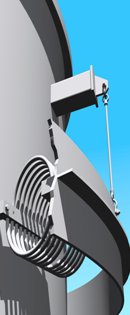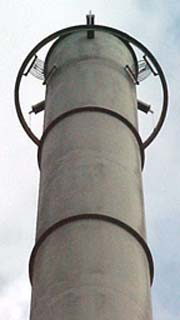Tuned Mass Dampers for Industrial Steel Stacks
Tuned Mass Dampers for Steel Stacks
Fox Equipment is the industry leader in the tuned mass damper technology for steel stacks. Our engineers have contributed to the tremendous advances in tuned mass damper design that have been achieved over the past several decades.
Contact Us Now to learn why an Fox Equipment solution is right for your project.
The tuned mass damper (TMD) or auxiliary mass damper, is a device consisting of a mass attached to a building or structure in such a way that it will vibrate at the same frequency as the structure, but with a phase shift. The mass is attached to the structure by a spring-dashpot system and energy is dissipated by the dashpot as relative motion develops between the mass and the structure.¹
Steel stacks are prone to move in a crosswind manner due to vortex shedding. Since steel stacks have very low inherent dampening, this movement is not easily stopped. Tuned Mass Dampers (TMDs) are passive, secondary vibration systems designed to increase the structural dampening of the primary system. Damping devices are attached to a chimney to increase its structural damping, thereby significantly reducing the cross-wind and along-wind vibrations, including the effects of aerodynamic interference by other nearby towers or chimneys.² The American Society of Mechanical Engineers Steel Stack Standard STS-1 prescribes the conditions under which vibration control such as a TMD is required.
Fox Equipment offers Tuned Mass Dampers meeting the requirements of ASME STS-1 and CICIND Model Code for Steel Chimneys.
Like downwind loads, vortex shedding forces are the product of pressure and area. The vortex shedding pressure is proportional to the stack’s critical wind velocity and the area is obviously proportional to its diameter. The higher a stack’s critical wind velocity and diameter, the higher its vortex shedding forces. The critical wind velocity is the wind velocity at which the vortex shedding frequency matches the stack’s natural frequency.
The Tuned Mass Damper works by transferring lateral forces to the stack from a mass suspended from the top of the stack. These forces are transmitted from the mass to the stack via flexible isolators affixed between the mass and the stack. The isolators and the mass are flexible to allow “tuning” of the secondary TMD system frequency to the primary stack system.
¹ The Role of Damping, Mass and Stiffness in the Reduction of Wind Effects on Structures. Fifth Colloquium Industrial Aerodynamics, Aachen Germany, June 1982.
² CICIND Model Code for Steel Chimneys.
Call us now at (904) 531-3150 or fill out our Contact Form to discuss options for tuned mass dampers custom manufactured and installed by Fox Equipment.


